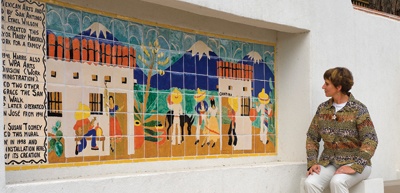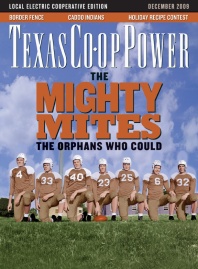A simple tile mural rescued from demolition offers a quiet reminder of San Antonio’s history.
The mural of a Mexican village scene—one of the highlights along the impressive new northward extension of the San Antonio River Walk—features the maguey cactus in bloom that was the logo of Ethel Wilson Harris at the Mexican Arts and Crafts Workshop she owned on the banks of the San Antonio River. The mural was made in the 1930s at the workshop just steps from its new location. And the route it took to get back to its prime new spot on the River Walk’s wall beneath the El Tropicano Riverwalk Hotel is part detective story, part history lesson.
“My idea was that this linked the old part of the river to the new part,” said Susan Toomey Frost, a collector and patron who saved the mural and has played a central role in identifying and recovering much of San Antonio’s tile heritage. “It came out really cool, I think—considering what it came through to get here. This is as close as possible to where the tile was made.”
The mural was commissioned for a relative’s private home by Maury Maverick, a congressman and mayor of San Antonio from 1939-41. “It was in a long galley kitchen. It was like a big backsplash—10 feet long and 3 feet high,” Frost said. “It was a bear to get it out.”
Frost is an enterprising collector, so she was contacted when the home, whose ownership had changed hands, was scheduled to be torn down in 1998. “I didn’t know it existed,” she said. “So I purchased the mural and got the guy to come take it out.” The “guy” was a California tile restorer, who arrived with a slim saw expecting a day of work and instead found the tiles set in concrete.
Frost is still amused as she recalls how the restorer kept going back to The Home Depot to purchase bigger saws, finally getting the tiles out safely several days later with big chunks of concrete attached to them. The concrete was removed from the back of the tiles at a workshop in Lytle, south of San Antonio. From there, they were taken to the Dunis Studios in nearby Bulverde, north of San Antonio, for final work that included the preparation of text tiles explaining the mural’s origins.
The restored mural portrays a variety of village scenes in its 100-plus original tiles, including men wearing sombreros, colorfully dressed women and whitewashed buildings in the foreground below three snow-capped volcanoes.
“Everybody along the way was very conscientious,” Frost said, tracing the line of one of the few visible cracks in the mural. “This crack was originally there.”
The Mexican Arts and Crafts Workshop turned out tile from 1931-41 in downtown San Antonio, on North Saint Mary’s Street in what had been a barn for a 19th-century mansion. In 1941, the workshop, now called Mission Crafts, moved within the walls of Mission San José y San Miguel de Aguayo, where artisans created tile and pottery until 1977.
The workshop’s founder, manager and promoter was Harris, who registered the trademark maguey. “She was really good at marketing,” Frost said, speaking fondly of Harris after years of research, almost as if she had known her in person.
Harris also served as technical supervisor for the Work Projects Administration’s arts and crafts division during the Great Depression. Mural subjects included the U.S. military and a century of sports in San Antonio, as depicted in four huge murals above the entrances to Alamo Stadium.
Meanwhile, the so-called San José tile being produced in San Antonio, primarily at Harris’ workshops, became a visible part of many projects, including two murals on the original River Walk.
The vast majority of the scenes and images portrayed on the tiles, bowls, plates and other pottery from the workshop are images straight from Mexican and South Texas rural life. Among the scenes in the vibrantly colored tiles are families riding to church on horseback, female dancers in flowing regional dresses, male guitarists with puffy-sleeved shirts, duck hunting, animals, fruit, calla lilies or sometimes traditional, geometric designs.
Toward the end of the 20th century, however, San Antonio’s tile heritage was becoming just a vague memory.
Frost, who as a collector uses the name “benignobsession” on eBay, started putting the pieces of history back together. As for the mural she helped rescue, some people presumed that the tiles came from San José, California. But knowing their San Antonio origin, Frost was intrigued enough to start almost two decades worth of research. The result is not only a major collection but also an art book, Colors on Clay: The San José Tile Workshops of San Antonio (Trinity University Press, 2009). A San José tile exhibit at the Witte Museum is scheduled to be up through March.
“This was too important historically; nobody had put it all together,” Frost said. “I like to collect things that nobody else recognizes at the time. We have a huge amount of tiles here and a wonderful tile history.”
The 1.3-mile expansion of the River Walk, known as the Museum Reach, opened at the end of May, and visitors can walk by the restored tile mural or see it while floating by on a river barge. Karen Adams of the San Antonio River Foundation said the project design used bridge underpasses along the route to develop a linear, outdoor art gallery.
Plans also are well under way for the eight-mile Mission Reach that will reconnect the river and the city’s historic Spanish missions with hike-and-bike trails, parks and public art. Frost has another tile mural ready to donate to the River Foundation for public view close to Mission San José.
——————–
Soll Sussman is a former correspondent and news editor for The Associated Press in Mexico. He returned to Austin to work on alternative and renewable energy projects and writes about everything except politics.


